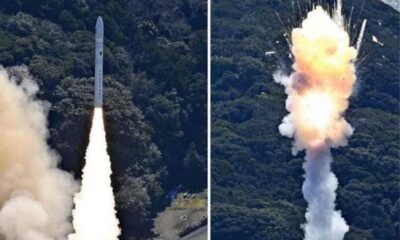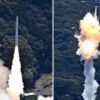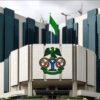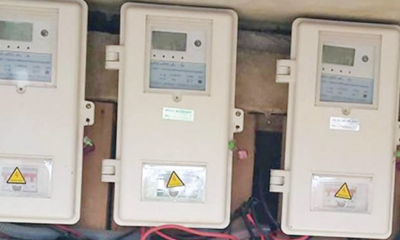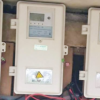Latest News
North Korea Attempts To Launch Satellite Fails At It Crashes Into The Ocean
In a blow to leader Kim Jong Un’s efforts to strengthen his military capabilities as tensions with the United States and South Korea rise, North Korea’s attempt to launch the country’s first spy satellite into space on Wednesday was unsuccessful.
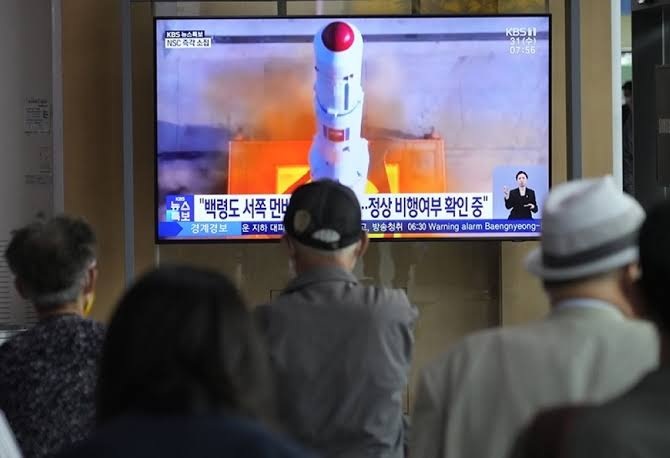
North Korea promised to perform a second launch after understanding what went wrong with its rocket liftoff after making an unusually swift acknowledgment of failure. It implies that Kim is still eager to increase his stockpile of weapons and put greater pressure on Seoul and Washington while diplomacy is stymied.
Japan and South Korea issued brief warnings to take cover during the launch.
In waters, 200 kilometers (124 miles) west of the southwest island of Eocheongdo, the South Korean military reported that it was rescuing an object believed to be a piece of the fallen North Korean rocket. Later, the Defense Ministry published images of a white metal cylinder that it claimed to be a rocket component.
North Korea is breaking UN Security Council resolutions that forbid the nation from performing any launch using ballistic technology by launching a satellite. According to observers, North Korea’s past satellite launches aided in the advancement of its long-range missile technology.
Recent North Korean long-range missile tests showed a possible range that might extend to the entire US continent, but outside experts claim the country still has some work to do to develop operational nuclear missiles.
The Malligyong-1 satellite was launched at 6:37 a.m. by the recently created Chollima-1 rocket from the North’s Sohae Satellite Launching Ground in the northwest. According to the North’s official Korean Central News Agency, the rocket lost thrust after its first and second stages separated, and it crashed off the western coast of the Korean Peninsula.
South Korea’s military said the North Korean rocket had “an abnormal flight” before it fell into the water.
Japan’s Chief Cabinet Secretary Hirokazu Matsuno told reporters that no object was believed to have reached space.
North Korean media said the country’s space agency will investigate what it calls “the serious defects revealed” by the launch and conduct a second launch as soon as possible.
“It is impressive when the North Korean regime admits failure, but it would be difficult to hide the fact of a satellite launch failure internationally, and the regime will likely offer a different narrative domestically,” Leif-Eric Easley, a professor at Ewha University in Seoul, said.
“This outcome also suggests that Pyongyang may stage another provocation soon, in part to make up for today’s setback.”
Adam Hodge, a spokesperson at the US National Security Council, said in a statement that Washington strongly condemns the North Korean launch because it used banned ballistic missile technology, raised tensions, and risked destabilizing security in the region and beyond.
The UN imposed economic sanctions on North Korea over its previous satellite and ballistic missile launches but has not responded to recent tests because China and Russia, permanent council members now locked in confrontations with the US, have blocked attempts to toughen sanctions.
Seoul’s military said it boosted military readiness in coordination with the United States, and Japan said it prepared to respond to any emergency.
The US said it will take all necessary measures to ensure the security of the American homeland and the defense of South Korea and Japan.
South Korea’s capital, Seoul, issued alerts over public loudspeakers and cellphone text messages telling residents to prepare for evacuation after the launch was detected, and Japan activated a missile warning system for Okinawa prefecture in southwestern Japan, in the rocket’s suspected path.
“Please evacuate into buildings or underground,” the Japanese alert said.
Japanese Defense Minister Yasukazu Hamada said Japan plans to keep missile defense systems deployed to its southern islands and in southwestern waters until June 11, which is the end of North Korea’s announced launch window.
KCNA didn’t provide details of the rocket and the satellite beyond their names. But experts earlier said North Korea would likely use a liquid-fueled rocket as most of its previously tested long-range rockets and missiles have done.
Though it plans a fuller investigation, the North’s National Aerospace Development Administration attributed the failure to “the low reliability and stability of the new-type engine system applied to (the) carrier rocket” and “the unstable character of the fuel,” according to KCNA.
On Tuesday, Ri Pyong Chol, a top North Korean official, said the North needed a space-based reconnaissance system to counter escalating security threats from South Korea and the United States.
However, the spy satellite disclosed in the country’s state-run media earlier didn’t appear to be sophisticated enough to produce high-resolution imagery. Some outside experts said it may still be able to detect troop movements and large targets such as warships and warplanes.
Recent commercial satellite imagery of the North’s Sohae launch center showed active construction indicating North Korea plans to launch more than one satellite. In his Tuesday statement, Ri also said North Korea would test “various reconnaissance means” to monitor moves by the United States and its allies in real-time.
With three to five spy satellites, North Korea could build a space-based surveillance system that allows it to monitor the Korean Peninsula in near real-time, according to Lee Choon Geun, an honorary research fellow at South Korea’s Science and Technology Policy Institute.
The satellite is one of several high-tech weapons systems that Kim has publicly vowed to introduce. Other weapons on his wish list include a multi-warhead missile, a nuclear submarine, a solid-propellant intercontinental ballistic missile, and a hypersonic missile. In his visit to the space agency in mid-May, Kim emphasized the strategic significance of a spy satellite in North Korea’s standoff with the United States and South Korea.
Easley, the professor, said Kim has likely increased pressure on his scientists and engineers to launch the spy satellite as rival South Korea successfully launched its first commercial-grade satellite aboard the domestically-built Nuri rocket earlier this month.
South Korea is expected to launch its first spy satellite later this year, and analysts say Kim likely wants his country to launch its spy satellite before the South to reinforce his military credentials at home.
After repeated failures, North Korea successfully put its first satellite into orbit in 2012, and the second one in 2016. The government said both are Earth-observation satellites launched under its peaceful space development program, but many foreign experts believed both were developed to spy on rivals.
Observers say there has been no evidence that the satellites have ever transmitted imagery back to North Korea.


